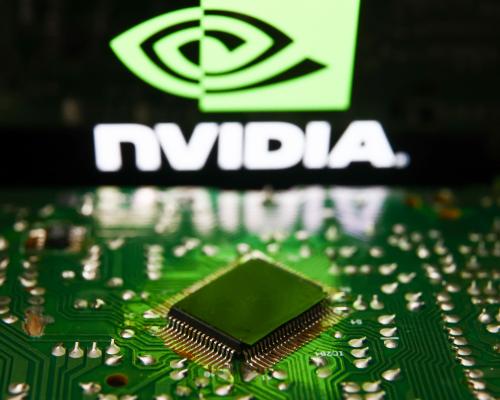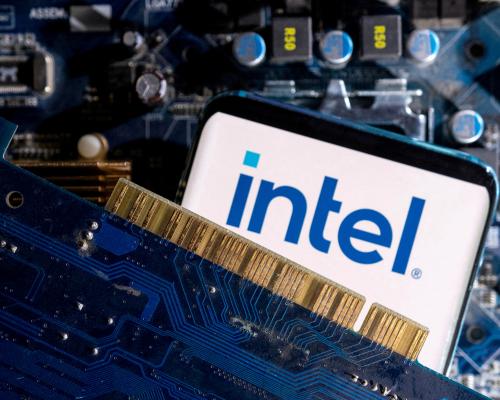
Hello, and welcome to TechScape. My Spotify playlists are undergoing a British invasion this week. Here’s what I’m listening to: PinkPantheress, Lola Young and Evita in London.
Privileges with the president
Donald Trump announced this week that two US chipmakers would tithe 15% of their revenue from sales in China to the US government. Paying for the license to sell to Chinese customers represents an unprecedented deal.
My colleague Helen Davidson reports from Taipei:
The chipmakers Nvidia and AMD have agreed to give the US government 15% of their revenue from advanced chips sold to China in return for export licences to the key market.
The arrangement will lead to Nvidia giving 15% of its revenue from Chinese sales of its H20 chips, and AMD giving 15% of revenue from Chinese sales of its MI308 chips, according to reports citing US officials.
The H20 and MI308 chips were banned from sale to China in April, despite the lower-powered H20 being designed specifically to abide by restrictions introduced by the Biden administration.
Nvidia’s CEO Jensen Huang, head of the most valuable company in the world at $4.44tn, has been lobbying the White House for months to open up sales in China, where the US still prohibits sales of Nvidia’s most advanced chips over national security concerns. In July, Trump relaxed some restrictions imposed by Joe Biden’s administration.
The deal with Nvidia and AMD seems as much about personally appealing to Trump as it does about generating revenue for the US government. The agreement has all the trappings of Trump entering into business with the chipmakers.
In a way, it’s a version of a playbook other major tech companies have been trying out as Trump is dramatically changing the international business landscape. Apple announced a $100bn investment commitment in US manufacturing. CEO Tim Cook, who had made the journey to the White House himself, presented Trump with a glass trophy (including 24 karat gold base) designating the president a graduate of the Apple Manufacturing Academy, launched in Michigan the week prior.
During his meeting with Cook, Trump said he would levy a 100% tariff on semiconductor chips, which could set both Apple and Nvidia back billions. However, the president said: “If you’re building in the United States of America, there’s no charge.”
Both Nvidia and Apple are likely to be exempted from the tariffs. Each appears to have paid for the privilege – Apple with its domestic investment, Nvidia with its revenue-sharing agreement.
OpenAI debuts GPT-5
OpenAI launched the new version of the artificial intelligence that underpins ChatGPT last week. There are quite a few aspects of the release to consider to understand it fully – what the company is saying, where the AI race between tech giants stands, the model’s new capabilities and pitfalls, the environmental impact – so I’ve rounded up the Guardian’s coverage of GPT-5 below.
OpenAI said GPT-5 has marked improved coding and writing capabilities over its predecessor. My colleague Dan Milmo reports:
OpenAI has claimed to have taken a “significant step” towards artificial general intelligence (AGI) with the launch of its latest upgrade to ChatGPT, but has admitted there are still “many things” missing in its quest to create a system able to do humans’ jobs.
Sam Altman, OpenAI’s chief executive, called the model a “significant step forward” to achieving the theoretical state of AGI, which the startup defines as a highly autonomous system that outperforms humans at most economically valuable work – or, in other words, can do their jobs.
Read the full story on the unveiling of GPT-5: OpenAI says latest ChatGPT upgrade is big step forward but still can’t do humans’ jobs
The race towards artificial general intelligence is running hot, with tech giants pouring hundreds of billions of dollars into the technology, but like OpenAI, Google and Meta acknowledge they have not reached that goal yet. Dan Milmo and Dara Kerr report: “[It is] missing something quite important, many things quite important,” said Altman, such as the model’s inability to “continuously learn” even after its launch. In other words, these systems are impressive but they have yet to crack the autonomy that would allow them to do a full-time job.
Last month, Mark Zuckerberg, chief executive of Facebook parent Meta, said development of superintelligence – another theoretical state of AI where a system far exceeds human cognitive abilities – is “now in sight”. Google’s AI unit on Tuesday outlined its next step to AGI by announcing an unreleased model that trains AIs to interact with a convincing simulation of the real world.
Read the full story: ‘It’s missing something’: AGI, superintelligence and a race for the future
How we know OpenAI’s new model is not an omniscient presence that will lord over all humanity: GPT-5 is making some goofy mistakes. It struggles with maps in a way a 10-year-old might. Per my colleague Josh Taylor: when Guardian Australia asked the latest model of ChatGPT to identify the number of Rs in Australia’s states and territories, it could identify those which did. But the AI also believed Northern Territory had just three Rs not five. When asked to produce it on a map, spelled the territory as “Northan Territor”.
Read the full story: OpenAI unveils ChatGPT-5 and its hyped ‘PhD level’ intelligence struggled with basic spelling and geography
GPT-5 is a more powerful model than its predecessor, meaning it will consume more resources to answer each query. Here’s what experts told Aisha Kehoe Down: “A more complex model like GPT-5 consumes more power both during training and during inference. It’s also targeted at long thinking … I can safely say that it’s going to consume a lot more power than GPT-4,” said Rakesh Kumar, a professor at the University of Illinois, currently working on the energy consumption of computation and AI models.
Given recent reports that ChatGPT handles 2.5bn requests a day, the total consumption of GPT-5 could reach the daily electricity demand of 1.5m US homes.
Read the full story: OpenAI will not disclose GPT-5’s energy use. It could be higher than past models
End of an era: AOL to discontinue its dial-up internet service after 30 years
Surprise: AOL, formerly known as America Online, was still offering dial-up internet service in 2025. My colleague Edward Helmore reports:
The hisses, pings and screeches that introduced millions of Americans to the nascent online world are to be formally retired when AOL’s dial-up internet shuts down in late September.
At its peak in the late 1990s and early 2000s, AOL had over 23 million subscribers in the US, making it the dominant internet service provider at the time.
Currently, only a small fraction of US households – about 175,000 – still rely on dial-up for internet access and web browser platforms.
In 2013, Pew Research found that just 3% of American households used dial-up internet. The 2025 figure represents less than 0.5% of the current population.
What once seemed ubiquitous in the US and UK is now a relic and only a partially important piece of the history of the internet. Many parts of the world that are now online never experienced – perhaps endured might be the more apt word – dial-up internet. They jumped straight to broadband, wifi, or the mobile internet, a phenomenon known as technological leapfrogging. If you’re feeling nostalgic for the early days of the internet, though, you can listen to the classic, grating sound of dialing into the web via Wikipedia’s page on the subject.
The wider TechScape
-
TikTok to replace trust and safety team in Germany with AI and outsourced labor
-
Companies aiding Trump’s immigration crackdown see ‘extraordinary’ revenues
-
Staff at UK’s top AI institute complain to watchdog about its internal culture
-
Social media accounts of Palestinians desperate for funds are being flagged as spam
-
‘A million calls an hour’: Israel relying on Microsoft cloud for expansive surveillance of Palestinians







